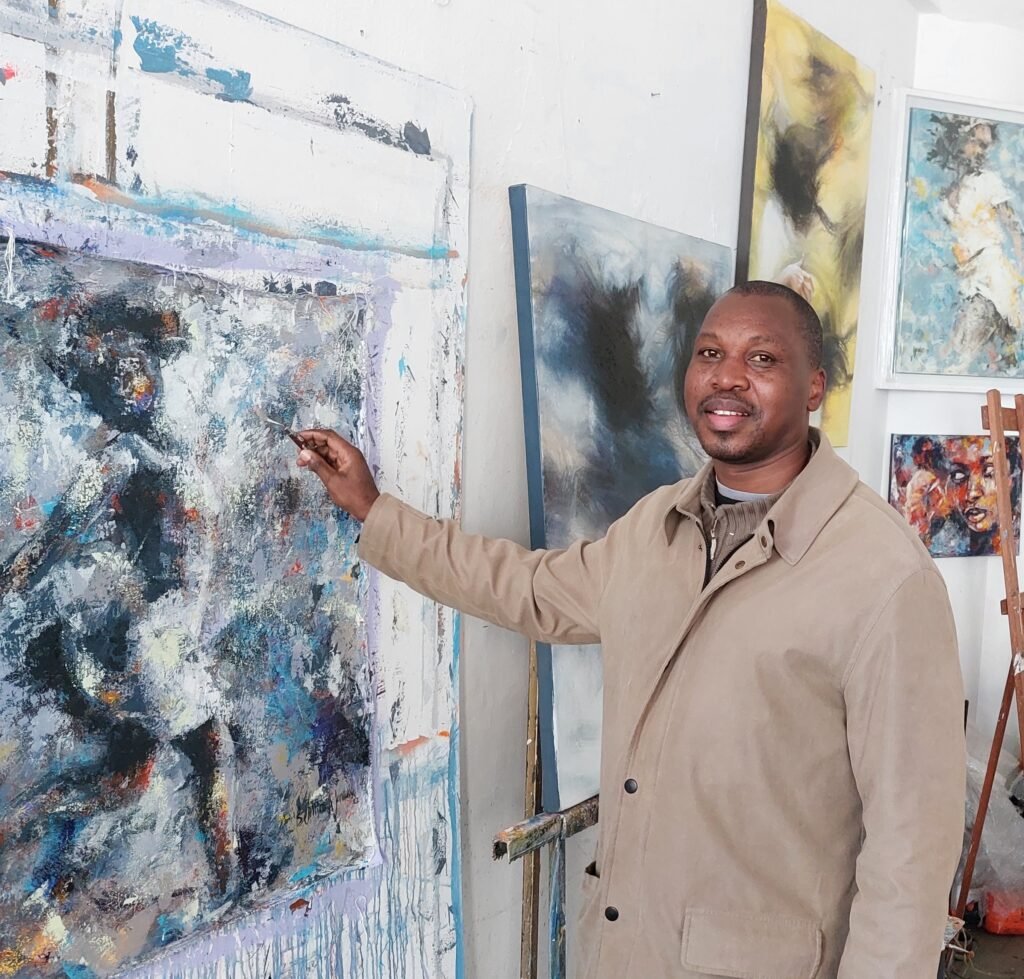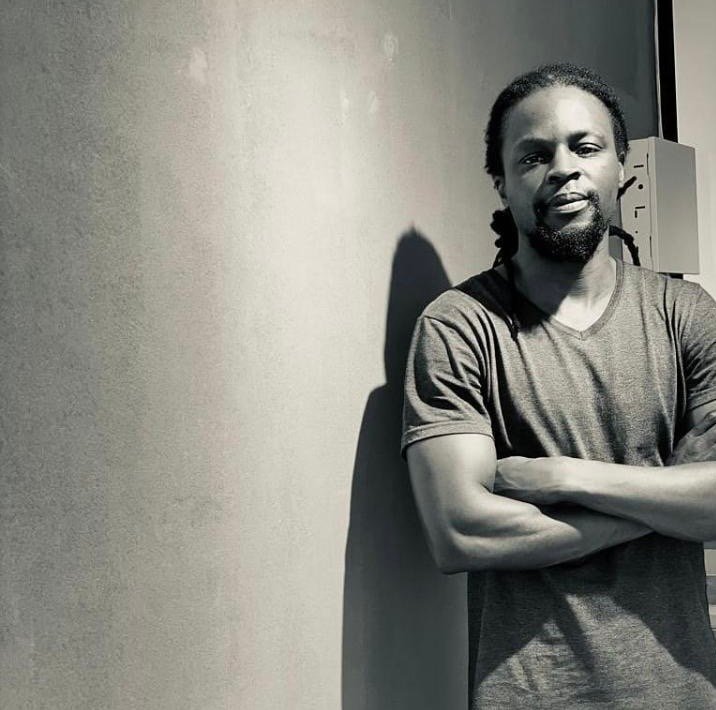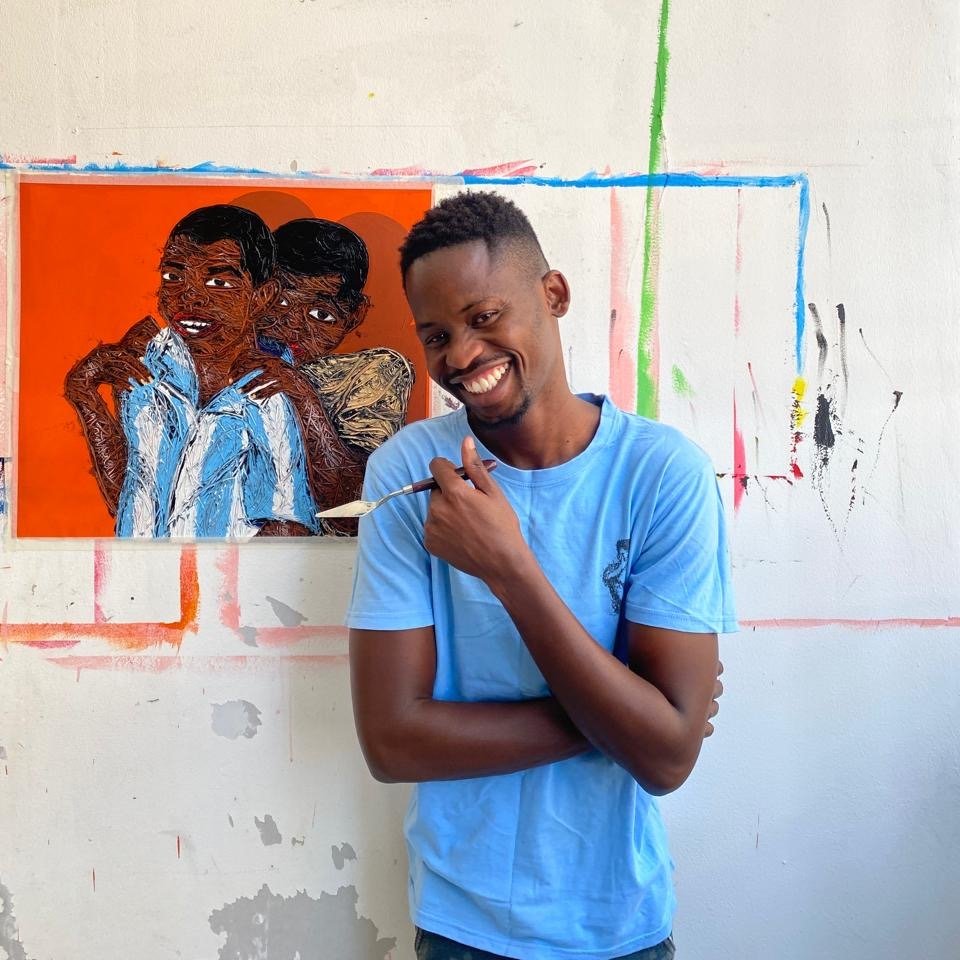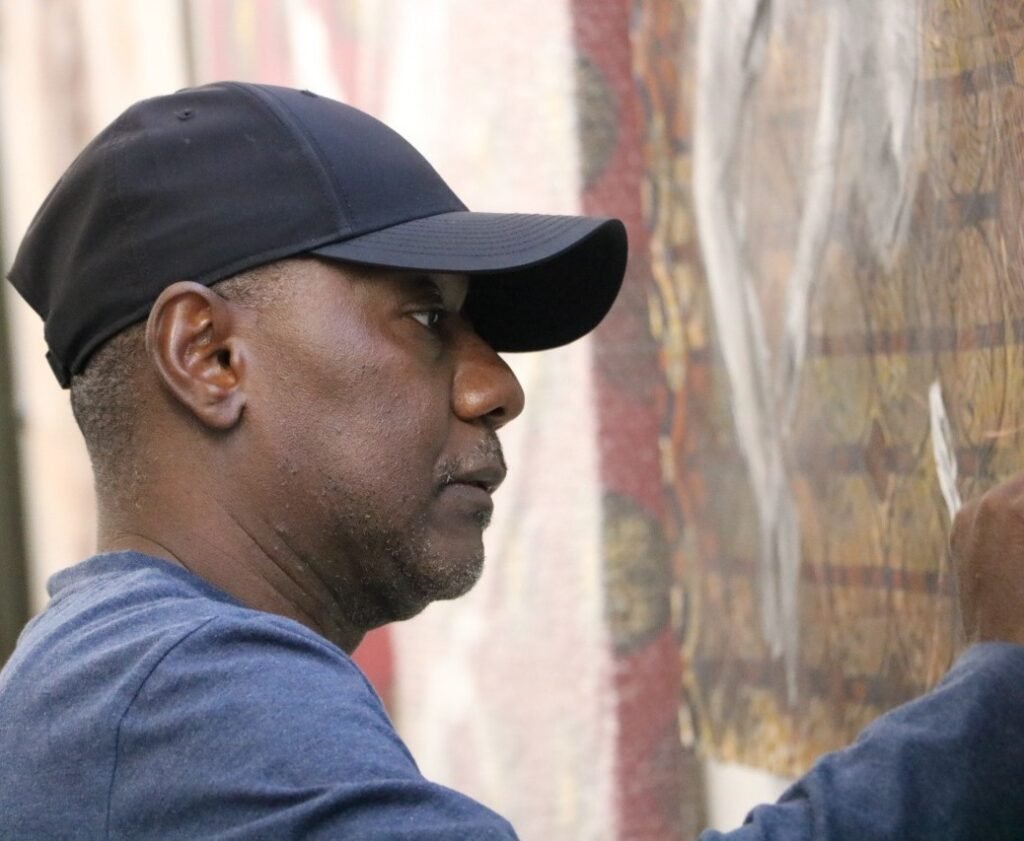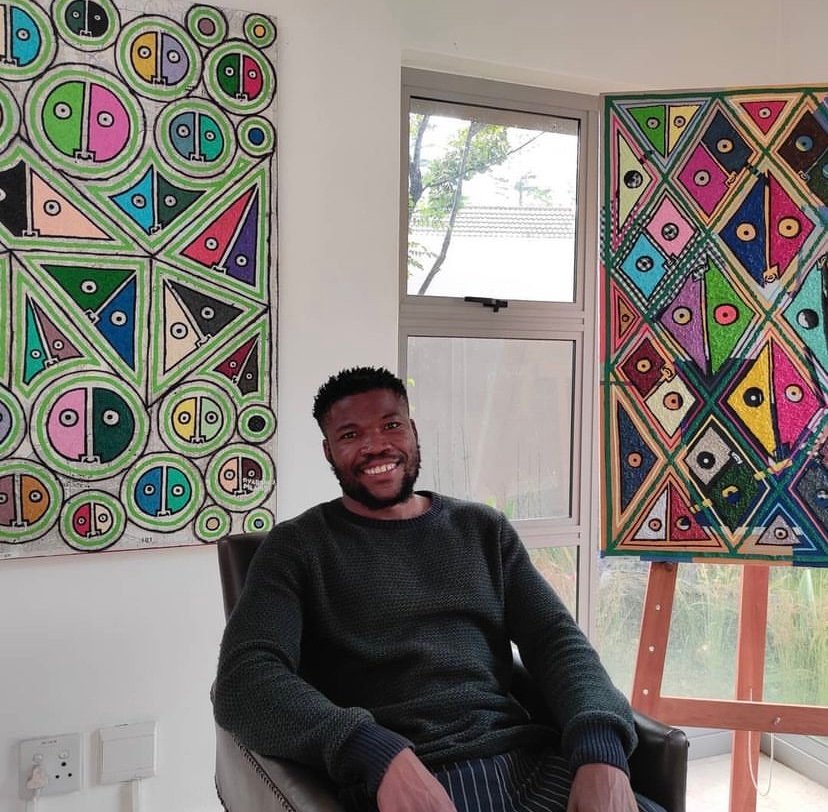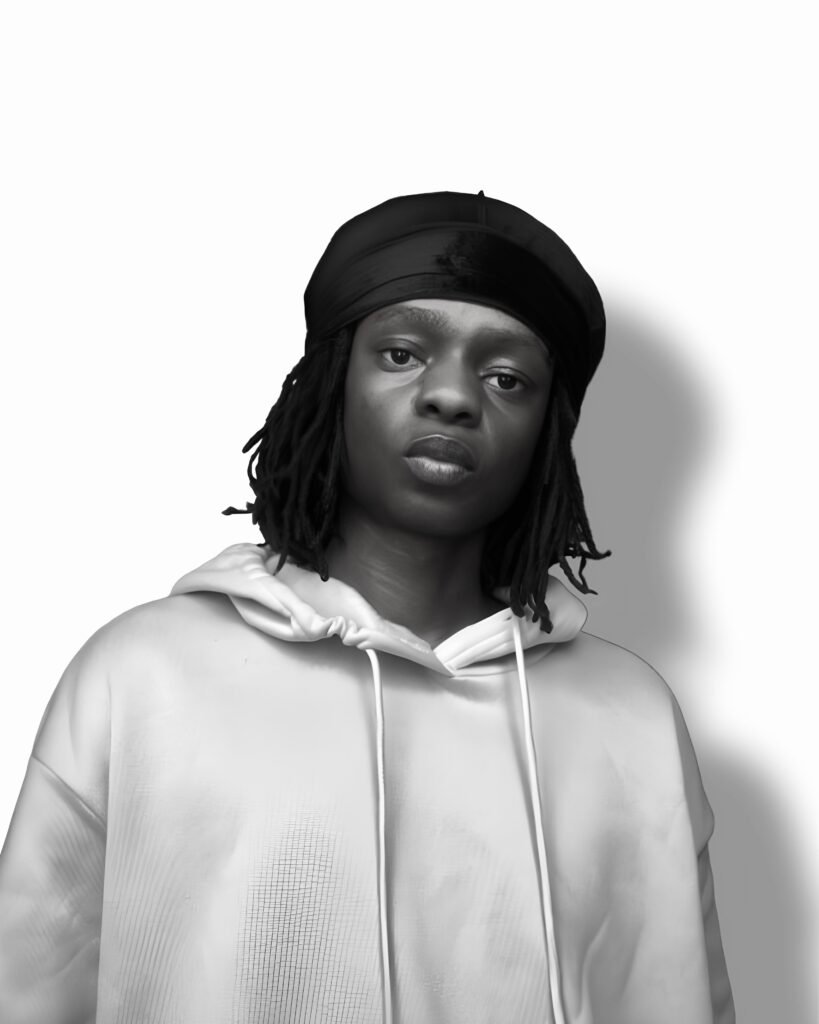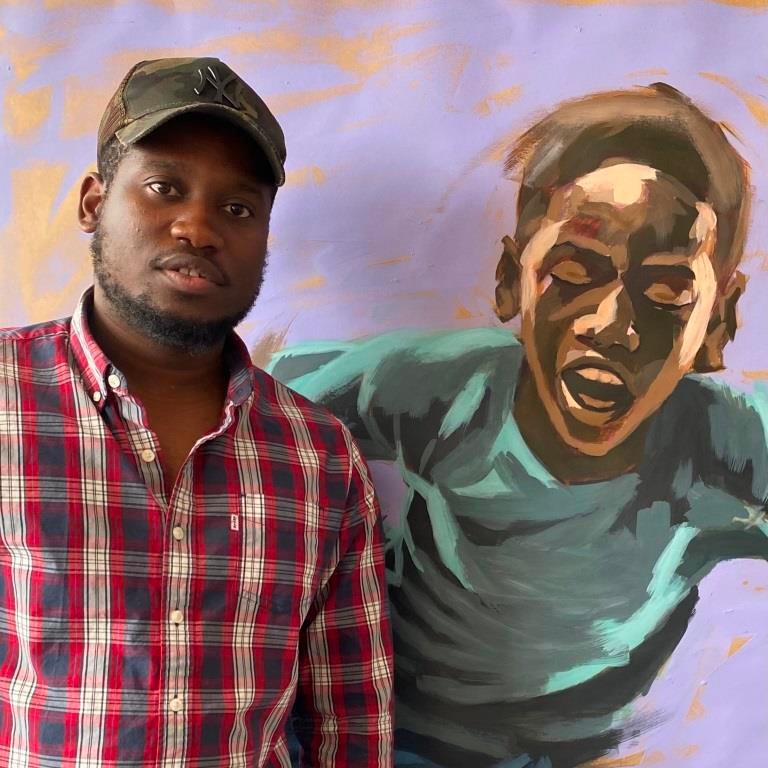
Muzi Phiri
On Auction
Introduction
Muzi Phiri, an innovative artist from Johannesburg, South Africa, is known for his visually compelling works that draw deeply from his surroundings. His artistic journey, rooted in the environment of Johannesburg and shaped by his early experiences, is a testament to the power of self-determination and a desire to reflect on human nature and life. His work explores themes such as identity, the complexity of the human psyche, and the relationship between people and the natural world, while engaging with the social and cultural dynamics of contemporary urban life.
Early Beginnings: The Seed of Creativity
Muzi Phiri’s first encounter with art was not in a formal classroom but rather through the play of a child’s imagination. Growing up in Johannesburg, a city teeming with diverse cultures and socio-political nuances, he was naturally drawn to the world around him. As a child, he was deeply fascinated by the act of creation, experimenting with crayons and pencils, sketching scenes from his environment, and using art as a form of self-expression. His early experiences with drawing were fundamental in shaping his sense of creativity and artistic vision. Through these simple but significant early encounters with visual arts, Phiri began to develop a deep-seated passion for working with various mediums.
Art for Phiri was, and remains, an instinctual part of his being. His first introduction to play, to the creative act itself, became the foundation of his lifelong engagement with the world of art. From sketching simple figures and abstract designs with crayons, his artistic journey grew more refined over time. The desire to bring his visions to life was born from this early sense of wonder and experimentation.
The Path to Professionalism
As Phiri matured, so too did his desire to deepen his engagement with art. He began to take his craft more seriously, developing an understanding of the various forms and techniques that could help him articulate his creative ideas more effectively. Inspired by the work of others, particularly artists whose works reflected the city and its surrounding landscapes, Phiri’s artistic practice evolved from the confines of childhood play into a profound exploration of his identity, his environment, and the complexities of human life.
Phiri’s development as a professional artist was not an easy path, but one driven by his insatiable curiosity and the drive to push himself through self-teaching and experimentation. The artist was self-motivated, constantly learning and refining his craft. He sought to understand the technical and conceptual aspects of art, which allowed him to move beyond simple sketches and into a more sophisticated body of work. It was this hunger for growth that led him to experiment with various artistic mediums, ultimately finding his niche in collage, a form of art that allowed him to combine his love for materials, textures, and layering with his introspective and conceptual approach.
Inspiration and Influences
Phiri’s work is deeply influenced by the artists and environments around him. Johannesburg, with its rich cultural history and its juxtaposition of natural beauty and urban chaos, serves as both a literal and metaphorical canvas for his work. Phiri’s themes are often rooted in his lived experiences and his observations of the environment that surrounds him, whether urban or rural. He is particularly inspired by the social complexities and realities that define the everyday life of Johannesburg residents.
Among the artists who have most significantly impacted Phiri’s work are David Koloane, Kay Hassan, and Sam Nhlengethwa. David Koloane’s ability to capture the nuances of Johannesburg’s social and environmental landscape, particularly his focus on the city’s everyday struggles and triumphs, resonates strongly with Phiri. Koloane’s work, which merges figuration with abstraction to depict the inner life of the city, provides a parallel to Phiri’s own exploration of the urban landscape and human emotion.
Kay Hassan’s powerful collages also left a lasting imprint on Phiri. Much like Hassan, Phiri is drawn to the use of fragmented images to create a holistic representation of complex narratives. Hassan’s approach to collage, which incorporates photography, painting, and found materials, informs Phiri’s own process of assembling imagery that reflects the fragmented, multifaceted experience of life.
Similarly, Sam Nhlengethwa’s work is a vital influence on Phiri. Nhlengethwa’s collages, often dealing with themes of identity, memory, and the psyche, are powerful examinations of the human condition. The impact of Nhlengethwa’s work on Phiri can be seen in his own treatment of materiality, colour, and form to express emotional depth and psychological complexity. Romero Bearden, a pioneer of collage and a major influence on Nhlengethwa and one of the earliest proponents of the mixed media way of working. Nhlengethwas inventive use of layered materials to tell stories and capture the essence of South African life has parallels to Phiri’s own exploration of daily life and urban living in Johanneburg.
Themes and Concepts
The core themes in Phiri’s work reflect his deep interest in nature, the human psyche, and the interactions between people and their environments. A recurring motif in his work is the complex relationship between the individual and the surrounding world—be it nature or the cityscape. His collages often depict figures in intricate, layered environments, suggesting that identity is shaped by external influences, be it social, cultural, or environmental.
Nature serves as a powerful metaphor in Phiri’s work. His use of organic forms and earthy tones often reflects his reverence for the natural world and the ways in which nature and humanity are intertwined. At the same time, the city serves as a constant presence in his work, representing the fast-paced, often alienating realities of modern urban life. Phiri’s work suggests that human beings are constantly in negotiation with both their natural surroundings and the man-made environment. Through his explorations of nature and urban landscapes, Phiri examines how people live, survive, and adapt in a world that is at once beautiful, dangerous, and unpredictable.
Phiri’s collages are often marked by an emotional depth that is conveyed through his choice of materials and colour. Each material, whether it’s newspaper clippings, photographs, or fabric, speaks to a particular emotional or psychological state. The juxtaposition of these elements serves as a metaphor for the fragmented, multifaceted nature of life in the modern world. The act of layering materials in his work suggests that identity and existence are never simple or singular but rather complex, multifaceted, and constantly shifting.
Moreover, Phiri’s focus on the human psyche echoes the work of many South African artists who have grappled with the psychological effects of living in post-apartheid South Africa. His collages often represent people in moments of introspection or contemplation, conveying an inquiry into the ways in which people relate to themselves, each other, and the world around them. This existential investigation forms the core of his artistic practice, reflecting his belief in the transformative power of art to explore and question the inner workings of the human experience.
Materials and Mediums
Collage, as a medium, has become Phiri’s primary mode of expression. There are predecessors to his ways of working like artists Romero Bearden, Sam Hlengethwa, and Kay Hassan, Phiri uses the medium to create layered, intricate compositions that explore the complexity of human existence. His collages are rich in texture and detail, often combining photographic elements, hand-drawn sketches, and various found materials. These materials, chosen for their texture and emotional resonance, allow Phiri to communicate nuanced feelings and concepts.
The use of colour is another hallmark of Phiri’s work. The palette he employs often reflects the mood or atmosphere of the piece, with bold, vibrant colours conveying a sense of urgency or intensity, while muted tones evoke introspection or contemplation. The material choices in his collages are equally important, with Phiri frequently using organic and urban elements—like torn paper, fabric, and photographs—to bridge the gap between the natural world and the man-made environment.
The Future of Art
For Phiri, the future is bright. He views art as a medium for social change and personal reflection, and he believes that the transformative power of creativity can shape a better world. As an artist who constantly seeks to evolve, Phiri is always exploring new ideas, new materials, and new ways to express his ideas. His work will undoubtedly continue to evolve as he delves deeper into the complexities of the human experience and the environment around him.
In an ever-changing world, Phiri remains committed to using his art as a means of inquiry, self-expression, and engagement with the larger community. His art speaks not only to the challenges of living in a modern urban environment but also to the broader human experience of survival, growth, and transformation. With a future that promises continued innovation and exploration, Muzi Phiri is an artist whose work will continue to resonate for years to come.
Conclusion
Muzi Phiri’s art is a powerful reflection of the world around him. Rooted in the vibrant city of Johannesburg, his work navigates the complexities of the human condition, the city’s environment, and the natural world. Through his use of collage and his deep engagement with materials and colour, Phiri creates works that speak to the psyche and soul of his viewers. His art is a testament to the power of creativity to explore, question, and ultimately transcend the boundaries of everyday life.

